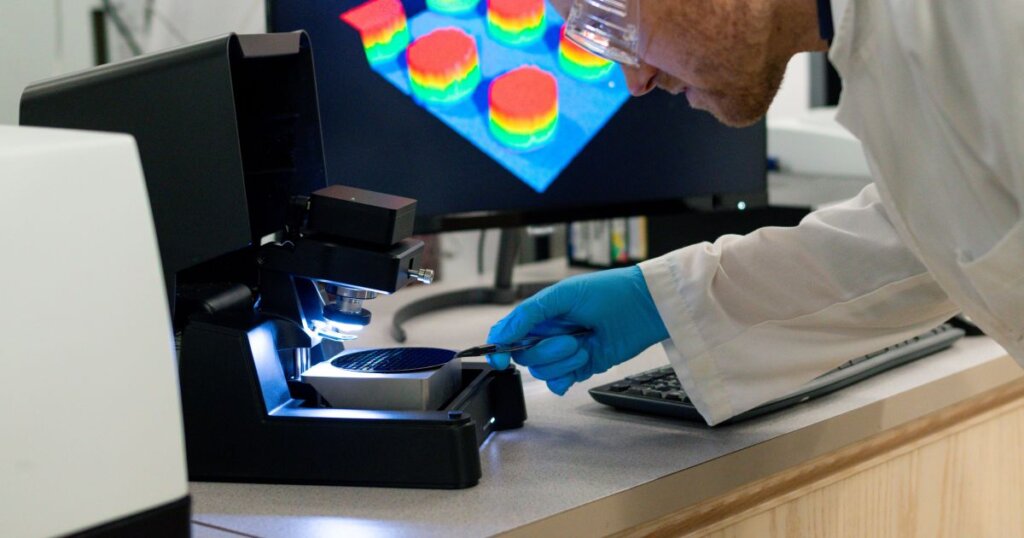Home » New microscope hardware is opening the doors for innovation
New microscope hardware is opening the doors for innovation

On Jan. 30, Kitchener-based ICSPI announced the release of its new Redux AFM, a special kind of microscope called an atomic force microscope (AFM). This is the company's second microscope, following its nGauge AFM released in 2017.
Unlike traditional microscopes that use lenses and light to magnify an object, AFM uses a probe to feel the surface of the sample using a probe. As the probe moves along the sample's surface, a sensor measures how the probe responds to its atoms and molecules. The result is a detailed 3D map allowing researchers and scientists to see the sample at an atomic and molecular level.
The company was founded in 2007 and is based on the PhD research of co-founder Neil Sarkar at the University of Waterloo under the supervision of Professor Raafat Mansour. Sarkar and Mansour are also co-founders of eye-tracking technology startup AdHawk. David Morris, director of operations at ICSPI, said it took ten years of research and development at the university to commercialize the technology.
“It's really a marvel of engineering. It's like something out of Star Trek where you can look at a sample down to the nanometre or sub-nanometer level on a benchtop in just a few minutes,” Morris said.
The first AFMs were released in 1989 and were quickly adopted by researchers worldwide for science, engineering and medical research. While the AFMs provided unparalleled images, the hardware was slow, and scans could take days
“Researchers were still using the same technology from the 80s. A good analogy is computing. In the 50s, computers were these giant things that took up a whole room. Today, you have more computing power in your pocket than those rooms had. It’s a similar thing with AFM. Before our microscopes, you needed a graduate-level degree in science and engineering to use one because of how complicated and frustrating they were,” he said.
ICSPI has solved these problems by miniaturizing all the moving parts of a traditional AFM microscope onto a single microchip.
“We’ve put the moving parts and sensors on a one square millimetre chip. We've also been able to simplify the driving electronics to get the product into a small form factor,” Morris said.
ICSPI’s microscopes have the potential to unlock new research across multiple fields. Morris said that the AFM technique has been held back by complex instrumentation.
“We hear it all the time from scientists and engineers who say they shy away from using AFM because it's such a pain, even though they get amazing, high-quality data. With the Redux, you have a benchtop tool that anyone can use, and it only takes a few minutes to get the data. It opens up new doors,” he said.
ICSPI is part of a large legacy of game-changing hardware companies from the University of Waterloo and its Velocity startup incubator. Morris said the Waterloo Region hardware and semiconductor scene should be discussed more. Along with ICSPI and AdHawk, Waterloo Region is home to Voltera, Clearpath Robotics, Avidbots, PEER Group LabsCubed, Miovision and FluidAI.
“I think the hardware companies are not loud enough here. There are a lot of good products being built here, and not just hardware, but microchips, too. Look at Teledyne DALSA, which is also a UWaterloo spin-out. You’ve got VueReal creating tools for manufacturing micro LEDs. There is a rich, growing semiconductor ecosystem in Waterloo Region,” he said.
Communitech
https://communitech.ca
"Communitech helps tech-driven companies start, grow and succeed. Communitech was founded in 1997 by a group of entrepreneurs committed to making Waterloo Region a global innovation leader. At the time it was crazy talk, but somehow this community managed to pull it off. Today, Communitech is a public-private innovation hub that supports a community of more than 1400 companies — from startups to scale-ups to large global players. Communitech helps tech companies start, grow and succeed in three distinct ways: - Communitech is a place – the center of gravity for entrepreneurs and innovators. A clubhouse for building cool shit and great companies. - Communitech delivers programs – helping companies at all stages with access to capital, customers and talent. We are here to help them grow and innovate. - Communitech partners in building a world-leading ecosystem – making sure we have all the ingredients (and the brand) to go from a small startup to a global giant."


